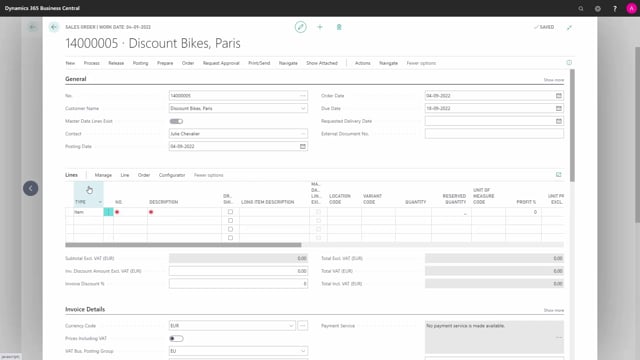
With the configurator, it’s possible to use the logical dependencies, which is a functionality we have in the Master Data Information app.
This means, as an example, if I’m entering a sales order line, but I don’t know which item to produce to because I have lots of bikes and the customer is asking me, there’s functionality here to search for items, and I could pre-fill with a template, so maybe I’ve made a mail template, and it defaults information here.
Now the interesting things about the logical dependencies are this.
If I select from my bike type list, I can select between eight or ten bikes.
If I select from my gear, I can choose between like eight different gears, seven gears in here.
Look at the gear with 20 and 21 gears.
Now once I’ve selected the bike type, for instance a city bike in here, and I look up in the gear, I can see that the list is now shortened because the logical dependencies had said that on a city bike you cannot have 20 or 21 gear, so I use this window to select on whatever the customer asks, and when I’m done selecting, I could search for items that fits the selection, and I can see I actually have no items with these scenarios.
I do have a city bike, and it mismatches on one criterion.
I’ll show this in other videos.
The interesting stuff here is if I didn’t select a bike, and I selected my gear first, and I selected for instance a 20-gear bike, and I look up now in my bike type, the selection also goes the other way, so you can only have a mountain bike with a 20 gear.
This is what we call logical dependencies, and you can set that up, there’s a video in the master data information collection, oh sorry, we call it the configuration dependency list, and in here you can set up, like we just said, that if the bike type is a city bike, the gear has to be different from 20 gear, or if the bike type is a mountain type, the gear can only be this and this, whatever.
We do have videos to explain this, but it’s part of a logical configuration flow, and the point of it is that it goes both ways, so if a customer starts saying, I would have a 20 gear bike, it’s easy to select other parameters, if he starts saying, I would like to have a mountain bike, you can select gear based on that, so it’s not a one way configuration flow.

